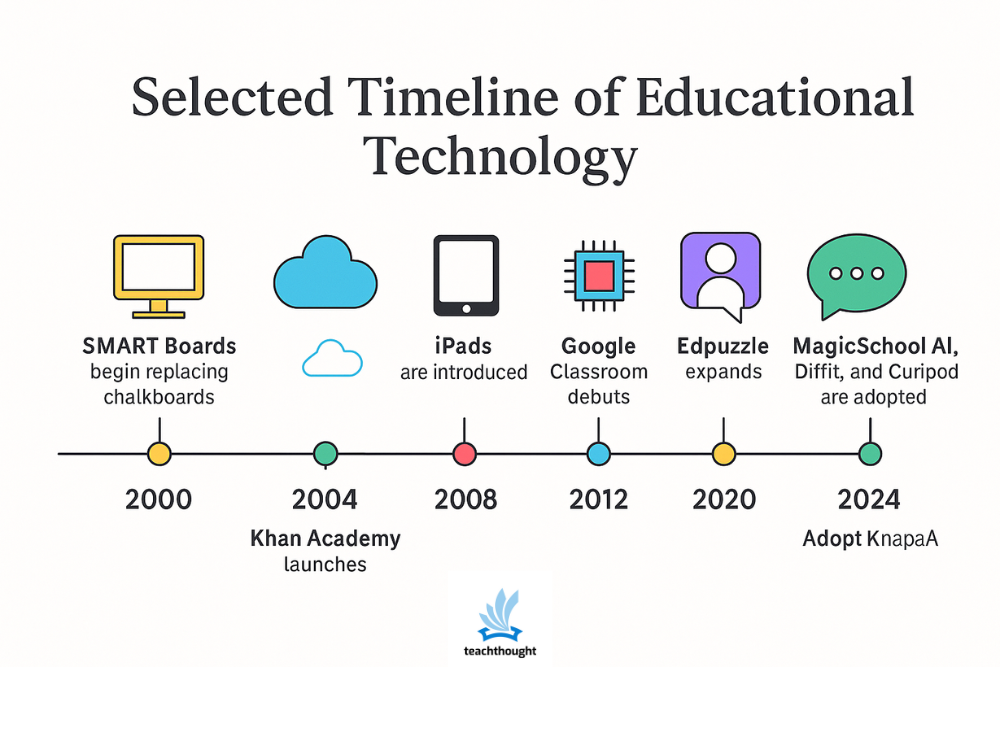Selected Timeline of Educational Technology (2000–2025)
2000–2003
Digital tools begin to enter classrooms, led by interactive whiteboards and early online platforms like Blackboard. The groundwork is laid for the shift from analog to digital teaching methods.
- SMART Boards begin replacing chalkboards in U.S. classrooms, offering early digital interactivity.
- Blackboard expands in higher education, centralizing syllabi, assignments, and grades.
- BrainPOP and Discovery Education launch subscription-based video and lesson resources for K–12.
- Microsoft PowerPoint becomes a staple for teacher presentations and student projects.
2004–2007
Cloud tools and open-source platforms gain momentum. YouTube and Google Docs mark a turning point in collaboration and content access.
- YouTube launches and begins its evolution into a major hub for educational video content.
- Moodle emerges as a free open-source LMS, enabling course delivery and student tracking.
- Google Docs introduces real-time browser-based collaboration for writing tasks.
- The Maine Learning Technology Initiative expands one-to-one laptop programs nationally.
2008–2011
The rise of mobile devices—especially iPads—begins to reshape how younger learners access digital content. Khan Academy sets a precedent for free, on-demand instruction.
- Khan Academy launches with short math tutorials, becoming a leader in free video-based instruction.
- iPads are introduced in 2010 and quickly integrated into K–2 classrooms for literacy and accessibility.
- Document cameras replace overhead projectors, allowing dynamic display and annotation of print content.
2012–2015
Google’s education ecosystem takes shape with the launch of Classroom and widespread Chromebook adoption. These years set the standard for cloud-first instructional delivery.
- Google Classroom debuts in 2014, simplifying the distribution and collection of digital assignments.
- Chromebooks outsell iPads in U.S. education for the first time, driven by cost and cloud integration.
- Nearpod and Pear Deck introduce interactive, device-based engagement with slides and polls.
2016–2019
Student voice tools, interactive video, and inquiry-based formats gain popularity. This period focuses on creation and engagement more than content access.
- Flipgrid enables asynchronous student video responses, becoming popular in classrooms globally.
- Edpuzzle expands the use of embedded video questions for formative assessment.
- Adobe Spark (now Adobe Express) becomes a tool of choice for student-designed projects, assignments, etc.
- HyperDocs emerge as teacher-designed Google Docs for student-paced, inquiry-based learning.
2020–2023
The COVID-19 pandemic accelerates full-scale adoption of digital instruction. Teachers embrace (because what choice did most have?) asynchronous tools and AI enters the education conversation.
- Remote learning during the COVID-19 pandemic drives mass adoption of Zoom, Google Meet, and Teams.
- Teachers use Screencastify and Loom to record asynchronous lessons and explanations.
- Khanmigo launches as Khan Academy’s GPT-4-powered AI tutor and teacher assistant.
- Wakelet, Padlet, and Jamboard (which has since by sunset) became popular for curation, brainstorming, and visual collaboration.
2024–2025
AI tools begin reshaping instructional design, feedback, and policy. Teachers adapt to a new era of automation, ethical dilemmas, and content generation.
- Teachers adopt MagicSchool AI, Diffit, and Curipod to scaffold texts, differentiate tasks, and build materials quickly.
- Districts implement policies on generative AI usage, focusing on academic integrity and authorship.
- Professional development shifts to emphasize prompt engineering, AI alignment, and instructional ethics.
- Educators redesign assessments to prioritize synthesis, real-world application, and multimodal expression.
